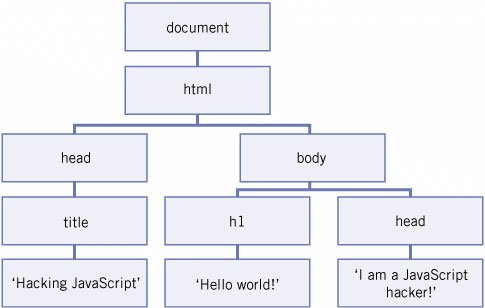Section A. Concepts
A. ConceptsBefore we delve deeply into the DOM, let's discuss a few general concepts. NodesTo the W3C DOM, everything in an HTML document is a node. The entire document is a document node; every HTML tag, such as <body>, <p>, or even <br />, is an element node; and the texts contained in these elements are text nodes. Furthermore, HTML attributes like ID are attribute nodes, and even comments are comment nodes. Node hierarchyNodes have a hierarchical relationship to each other. Take this HTML snippet: <p>I am a JavaScript hacker.</p> The snippet contains two nodes: one element node for the <p> tag, and one text node that contains 'I am a JavaScript hacker'. Since the <p> node contains the text node, their relationship becomes parent (<p>) and child (text). In this hierarchical way, all nodes form a document tree. This tree starts at the document node itself and continues to branch out until it has reached all text nodes that reside at the lowest level of the tree. Take this simple HTML page: <html> <head> <title>Hacking JavaScript</title> </head> <body> <h1>Hello world!</h1> <p>I am a JavaScript hacker!</p> </body> </html> The Level 1 DOM sees it as the following node tree: Figure 8.1. The DOM treeview of the HTML snippet. Node typesDocument, html, head, body, title, h1, p, 'Hacking JavaScript', 'Hello world!', and 'I am a JavaScript hacker' are all nodes. They're not all the same type of nodes, though. The document is a document node, the three texts are text nodes, and the six HTML tags are element nodes. The node type determines what you're allowed to do with a node. For instance, text nodes cannot contain other nodes, so, unlike element nodes, they have no child nodes. On the other hand, they have a few properties for reading out the text, which is something element nodes can't do (and don't need to do). Family treeAll these nodes have relationships to each other, and the DOM uses terminology borrowed from family trees to describe these relationships. Every node except for the document has a parent node. For instance, the parent node of the <body> element node is the <html> element node, and the parent node of the 'Hello world!' text node is the <h1> element node. Most element nodes have child nodes. For instance, the <head> node has one child node: the <title> node. In turn, the <title> node has a text node as its child node. Some nodes are siblings because they share a parent. For instance, the <h1> and <p> nodes are siblings because they're both child nodes of the <body> node. Nodes can have descendants and ancestors. Descendants are all the nodes that are children of a node, or children of those children, etc. For instance, all text nodes are descendants of the <html> node, while the second and third text nodes are descendants of the <body> node. Ancestors are nodes that are parents of a node, or parents of this parent, etc. All text nodes have the <html> node as an ancestor, while the second and third text nodes have the <body> element as an ancestor. Finding elementsYou can run up and down this family tree in order to find nodes. For instance, the <h1> node contains a property parentNode that refers to its parent: the <body> node. You can also directly find an element with a certain ID (getElementById()) or all elements with a certain tag name (getElementsByTagName()). Changing the treeThe W3C DOM allows you to change the node tree of a document. The following snippet changes the document tree: var x = document.getElementsByTagName('h1')[0]; var y = document.getElementsByTagName('p')[0]; x.parentNode.insertBefore(y,x); Figure 8.2. The DOM tree as rendered by the browser before (above) and after (below) the script has run. The <h1> and <p> nodes now trade places, both in the DOM tree and in the browser window. This shows the great power of the W3C DOM: any change to the tree is immediately rendered by the browser and becomes visible to your users. Creating elementsThe W3C DOM also allows you to create new elements and insert them in the document tree. This means that you can add anything to the document: status texts, new data obtained from an XMLHttpRequest script (see Chapter 10), or anything else that strikes your fancy. It's even possible to completely rewrite an HTML page. Just remove all nodes in the document and append new nodes to it, including, if you wish, new style sheets and JavaScript files. This is rarely done; it's usually easier to simply load a new page, but the W3C DOM allows it. |
EAN: N/A
Pages: 116

